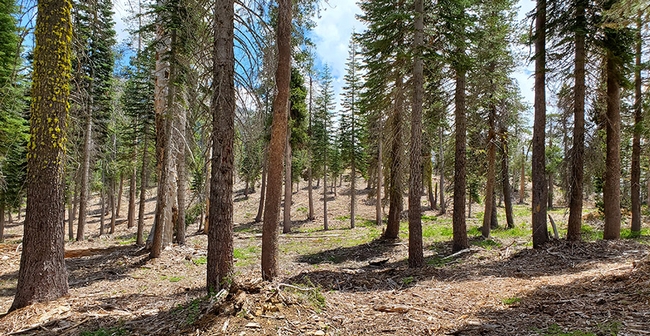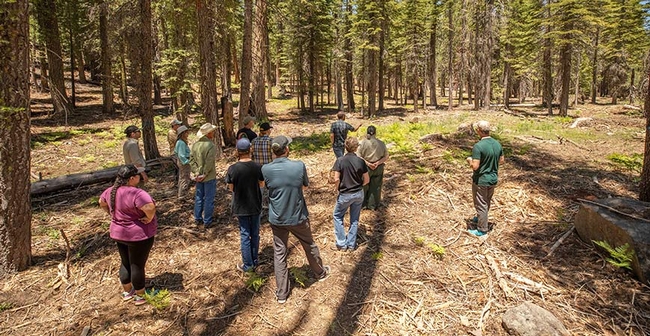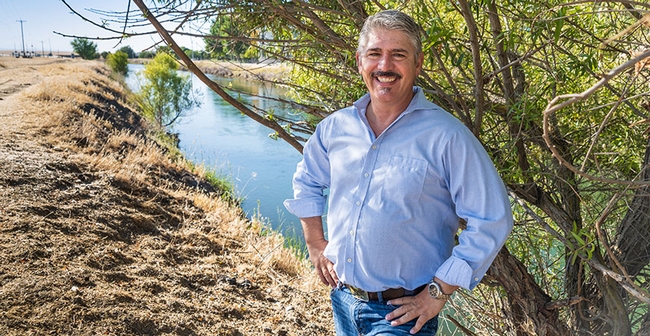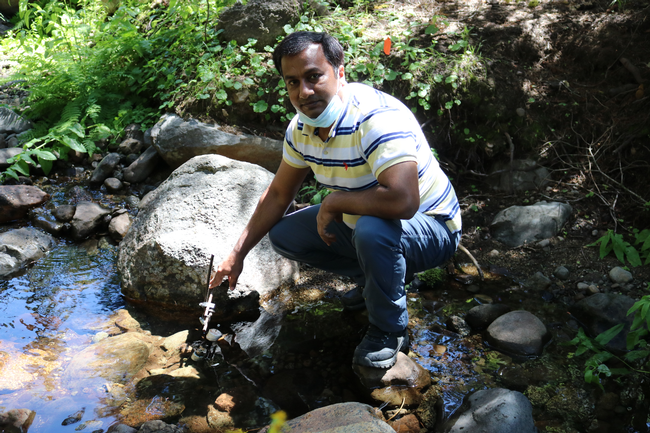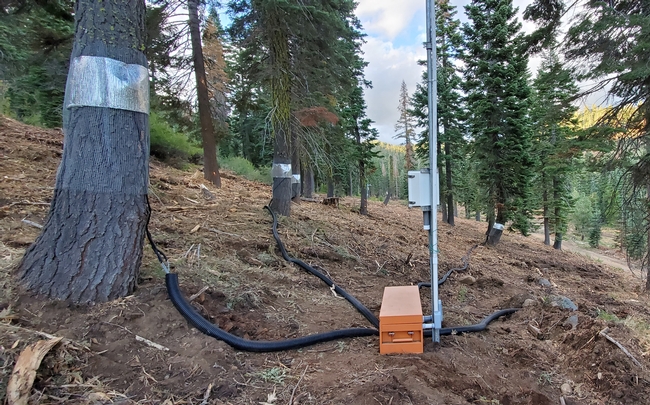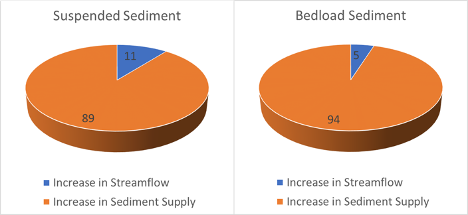Posts Tagged: Safeeq Khan
Study shows how restoring California's overstocked forests yields multiple, diverse benefits
Mechanical thinning of overstocked forests, prescribed burning and managed wildfire now being carried out to enhance fire protection of California's forests provide many benefits, or ecosystem services, that people depend on.
In a paper published in Restoration Ecology, researchers at UC Merced, UC ANR and UC Irvine reported that stakeholders perceived fire protection as central to forest restoration, with multiple other ecosystem services also depending on wildfire severity. Researcher Max Eriksson, lead author on the paper, noted that "forest restoration involves multiple fuels-reduction actions that were perceived as benefiting fire protection, with some also offering strong benefits to other ecosystem services such as air quality, wildlife habitat, soil retention and water supply."
The study showed that the total effect of an action such as mechanical thinning of forests aimed at reducing fuels includes not only the direct effect on reducing wildfire severity, but also secondary effects that improving fire protection has on benefits such as providing water and hydroelectricity for agriculture and communities across the state or storing carbon and reducing carbon-dioxide emissions from wildfire to the atmosphere. Fire management is therefore central to human well-being.
Across the western United States, researchers are addressing the huge challenge of transforming forest management from the historical goal of maximum resource extraction (e.g., timber production) to a paradigm built on multiple benefits, or ecosystem services.
The study involved a series of virtual workshops with natural-resource professionals, including forest managers, to understand their perceived effects of management actions on ecosystem services and the interactions of the various services. Eleven ecosystem services and nine currently used management actions were considered.
Safeeq Khan, co-author and UC ANR Cooperative Extension specialist in water and watershed sciences, adds, "Understanding both actual and perceived benefits provided by restoring overstocked forests is crucial to guiding the choice of management actions, public support, policy initiatives and investments by beneficiaries, i.e., monetizing ecosystem services."
UC Merced Professor and co-author Roger Bales points out that "reducing fuel loads is increasingly being recognized as an effective measure to transition our forests across the western United States from a destructive to a beneficial wildfire regime."
Bales adds, "Our research supports the perception that California's wildfire-vulnerable forests should primarily and urgently be restored to conditions that better regulate wildfire severity, and thus provide greater fire protection and other ecosystem-service benefits. Lower-severity wildfire is a natural and beneficial part of these ecosystems."
An important contribution of this study is the breadth of both ecosystem-service benefits and management actions considered. Study collaborator and ecosystem-service expert Benis Egoh, an assistant professor at UC Irvine, points out that, "This research recognized that given the complexity of forest ecosystems across the western United States, the investments required and the management constraints, increasing forest resilience requires a range of actions." She adds, "Accounting for perceived interactions of ecosystem services is key to multi-benefit valuation of restoration investments and to monetizing those benefits in equitable ways."
UC Merced leads innovative effort to secure water for agriculture and ecosystems
UC Merced's largest research grant in its 16-year history aims to improve agricultural and environmental water resilience. The new $10 million collaborative focuses on water banking, trading and improvements in data-driven management practices to arrive at a climate-resilient future in water-scarce regions of the United States.
The U.S. Department of Agriculture announced it is funding the wide-ranging effort from multiple institutions across three states through its National Institute of Food and Agriculture's Agriculture and Food Research Initiative on Sustainable Agricultural Systems. The coalition of researchers is led by UC Merced, joined by experts from UC Berkeley, UC Davis, UC Agriculture and Natural Resources, Utah State University, the New Mexico Water Resources Research Institute at New Mexico State University, the Public Policy Institute of California, Environmental Defense Fund, and the U.S. Geological Survey's Southwestern Climate Hub.
“There are a lot of challenges in balancing the needs of agriculture and ecosystems, and climate change and drought are only exacerbating difficult decisions about how to sustain water resources,” lead project director UC Merced Professor Joshua Viers said. “But our team of advisors, educators and scientists are eager to enable data-driven decision-making for securing a climate resilient future for our water-stressed regions.”
The partners in the USDA funded collaboration — Securing a Climate Resilient Water Future for Agriculture and Ecosystems through Innovations in Measurement, Management and Markets or SWIM — will focus on developing more robust, data-driven information systems for decision-makers such as land and water managers. SWIM is designed to provide objective measures of supply and demand, and incorporate drought forecasting and climate change trends.
The research and extension team, by working with local decision-makers, will improve the accuracy of measurement in water budgets, evaluate novel management strategies such as on-farm aquifer recharge, and evaluate water trading and markets to improve sustainable surface and groundwater use.
The SWIM project will work across disciplines and stakeholders, integrating research, extension and education in three testbeds with unique water policies and systems: Cache Valley, Utah; Mesilla Valley, New Mexico; and the San Joaquin Valley. All of them grow orchard crops and alfalfa, and all are in a drought. Like California, Utah is experiencing an unprecedented drought, where 99 percent of the state is in extreme or exceptional drought. And, like California, the physical and cultural geography of New Mexico is extremely diverse. Exploring all innovative avenues of water management is necessary for sustaining a future for agriculture and surrounding communities while balancing ecosystem needs across the west, Viers said.
SWIM's leadership plans such activities as workshops and field days to actively engage stakeholders, including the extension-grower networks of each state's university system, as well as land, water and ecosystem managers.
Researchers from UC Merced include Viers, professors John Abatzoglou, Tom Harmon, Teamrat Ghezzehei, Josué Medellín-Azuara and Colleen Naughton, UC ANR Extension Specialist Safeeq Khan, Chelsea Arnold, who oversees the CalTeach program through the School of Natural Sciences, and researchers Leigh Bernacchi, Max Eriksson and Nicholas Santos.
“The SWIM project aims at bringing the sustainability science from ‘silos' to impact by systematically engaging our stakeholders and clientele in the knowledge co-production and systems thinking,” said Khan, UC Cooperative Extension specialist in water and watershed sciences.
“The project will build on the existing work of UC ANR networks and academics in understanding the needs of growers, irrigation districts, and ecosystem managers and co-developing data and tools to help adopt and adapt climate-resilience strategies. Our emphasis is not only on producing science and decision-support tools, but also using the project as an opportunity for social learning, knowledge empowerment, science communication, and workforce development through extension and outreach.”
In addition to ongoing activity at UC ANR's Kearney Research and Extension Center, one of the testbeds in California will be the new UC Merced Experimental Smart Farm. Researchers will collect soil, water and crop data, track droughts, conduct water accounting and life-cycle assessments, and produce user-focused data and analysis there and in the other two regions.
“The western United States is experiencing declining surface water and groundwater, adding stress on all aspects of the social-hydrological system,” said co-investigator Sam Fernald, director of the New Mexico Water Resources Research Institute at New Mexico State University. “The lessons learned in this project will offer a blueprint for addressing future water challenges, not just in the West, but other locations worldwide facing similar water shortage issues.”
The researchers want to answer many pressing questions, such as how much the changing characteristics of multi-year droughts alter people's willingness to engage in water trading and banking as part of climate resilience efforts; whether drought early warning systems propel water trading; how ecosystem services can be maintained while adapting agricultural water management to anticipated extremes; what are the key drivers and barriers adopting or participating in water markets; and how new data and technology can reduce costs and barriers.
They will also look at how climate change impacts can be mitigated through a rainy-day storage option called managed aquifer recharge or MAR, as well as water trading at multiple scales and land-use planning so that agriculture and the environment can be sustained.
One key component of creating a sustainable future is through educational programming, one of the core activities of the grant. The Climate Adaptation Science Academy will give affiliated graduate students the jump on their careers as leaders in science and engineering by providing training in climate adaptation science, communications and complex systems problem solving.
“Expanding the reach of our program are transformational K-12 educational tools,” Viers said. “Educators and graduate students will develop curricular materials for AgSTEM education pathways reaching from rural, regional middle schools to the teachers serving underrepresented groups.”
The SWIM team plans to develop such tools as games that support computational thinking and decision-making, activities in which students learn about agriculture and careers in smart farming, and hands-on experiential learning.
As associate dean for research in the School of Engineering and the director of the campus's branch of the Center of Information Technology and Research in the Interest of Society (CITRIS and the Banatao Institute), Viers discussed the role of UC Merced in providing tangible solutions to pressing societal problems:
“It has been clear for some time that water scarcity is our new reality, and we know we need to do things differently,” he said. “This research award is the largest that USDA makes to universities, and it is clear that they believe UC Merced and our affiliates are the right team with the right ideas to help secure a climate resilient water future.”
Originally published at https://news.ucmerced.edu/news/2021/uc-merced-leads-innovative-effort-secure-water-agriculture-and-ecosystems.
New research clarifies impacts of timber harvest on sediment in watersheds
To effectively reduce these adverse effects of harvest, foresters first need to know the precise causes of sediment increases. Historically, researchers investigating the effects of timber harvest on the land have considered two primary drivers: hydrologic changes following timber harvest or fuel reduction that drive sediment transport, and increased sediment supply from ground disturbances and/or mass movements that result from those harvest or fuel reduction activities.
While these causes are tightly linked, little is understood about the relative role each plays in transporting sediment from the watersheds. In other words, which is dominant in increasing sediment delivery and transport: increased streamflow due to greater water availability that can sweep up and transport sediment, or a greater supply of sediment entering the waterway in the first place?
A new analytical approach developed by Safeeq Khan, UC Cooperative Extension specialist in water and watershed sciences at UC Merced, and collaborators now provides valuable insights into this issue, and ways to target effective mitigation strategies.
Published in the Journal of Hydrology last fall, the team's study analyzed long-term (1952-2017) streamflow and sediment data from two adjacent paired watersheds in the H. J. Andrews Experimental Forest in the western Cascades Range of Oregon. One of the watersheds was harvested and replanted in the 1960s, while the second was not disturbed and used as a control.
“The data is from Oregon, but highly relevant for our work in the Sierra Nevada,” said Khan, lead author of the study. “We have tried to quantify the effect of hydrologic changes and increased sediment supply from logging activities on total sediment yield.”
To isolate the relative contributions of streamflow changes and increased sediment supply on sediment transport, Khan and colleagues developed a statistical reconstruction technique to account for the hydrologic changes following harvest.
“This approach allows us to analyze and estimate background sediment production in the treated watershed during the post-treatment period as if the harvest had not occurred, which is remarkable,” said Khan.
The new approach demonstrated that sharp increases in sediment following harvests can be confidently attributed to ground disturbances associated with timber harvest or thinning operations to reduce fuel. Changes in sediment supply overwhelmingly dominate streamflow in terms of contributions to increased sediment in the watershed. Streamflow increases alone led to modest increases in sediment, less than 10%, with the watershed transporting about twice as much total sediment than it would have had the area been left unharvested. This effect diminishes more or less exponentially over time, especially with respect to suspended sediment, as bare areas revegetate, which reduces hillslope sediment supply, and as streamflow returns to pre-treatment levels.
“Once we know the background sediment production, we can easily attribute how much of the increase is due to what mechanisms” said Gordon Grant, a hydrologist with the U.S. Forest Service Pacific Northwest Research Station and co-author on the study.
“Determining that increased sediment in watersheds after harvests is primarily driven by ground disturbance is crucial in targeting mitigation efforts,” explained Khan. “Now, we know that strategies that limit ground disruption – like suspending logs while transporting instead of dragging them, avoiding heavy machinery when and where possible, and mastication and mulching – are likely to be highly effective in reducing sediment yields.”
These changes are most pronounced in the first few years following harvest, but the treated watershed did not return to pre-harvest levels of sediment for two decades, underscoring the long-term effects of harvest on a forest's hydrologic and geomorphic systems.
While clearcutting is no longer practiced on U.S. federal land, it is still the primary timber harvest method used across the globe. Additionally, many other types of forest disturbances such as wildfires, mass tree die-offs, and salvage logging create hydrogeomorphic conditions not too different from clearcutting.
"Our findings provide insights that can help land managers and foresters better target land management and restoration in the future,” said Khan. “We're hopeful that these results will lead to strategies that minimize the long-term impacts and legacies of intense land-use disturbances.”
The full study, titled “Disentangling effects of forest harvest on long-term hydrologic and sediment dynamics, western Cascades, Oregon" is available online in the Journal of Hydrology at https://www.sciencedirect.com/science/article/pii/S0022169419309941?via%3Dihub.


